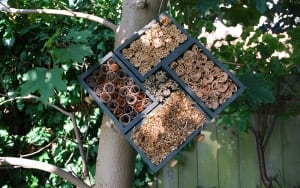
Many species, including lacewings, ladybirds and solitary bees, hibernate over winter. They also need a safe, dry place to store their eggs until spring arrives.
But their natural habitat is disappearing, so it is down to us gardeners to provide a home or insect hotel for them. And you can make one using just recycled materials!
Download my free guide to making all different types of insect hotels!
Insect Hotel step by step guide
You can use anything as a container, but here I’m going to show you one I made using the drawers from a little wooden storage unit.
First, arrange the drawers to make one large container and screw them together. Then paint the wood with fence stain to protect it from rain damage.

For my filling I used straw, card and pampas grass, but there are alternatives. Hollow bamboo canes are ideal while twigs, pine cones and dry leaves will house a huge range of insects.
Cut out the seed head stems of bamboo and chop them into lengths that fit into your container. They will make hollow cavities that are perfect for insects to use as nesting tubes.

Because they are fluted, you will end up with a range of hole sizes suitable for different species.
Next, bunch together some pampas grass leaves and cut them into lengths. It helps to hold them together with elastic bands – loom bands are ideal.

Repeat the process with bunches of straw.

Next, take some thin card, like the inner tube from a roll of wrapping paper. Roll it up and hold in place with elastic bands.
Try folding the edge before you roll to give a range of shapes and designs.
Slot your fillings into the container, making sure to pack them quite tight. Otherwise they will fall out when you hang it.
Now hang your hotel. It should be about 1.5m off the ground in a sunny, sheltered spot. And just wait for some residents to move in!
If, like mine, your insect hotel is open-fronted, it may get damaged by heavy winter rain. The contents may rot and kill the insects inside.
Protect your residents by moving the insect hotel to a cool, dry place over winter – a shed or garage is ideal. Don’t bring the insect hotel into your home – the insects need to be kept cool. Then put it back out in spring.

Leave A Comment